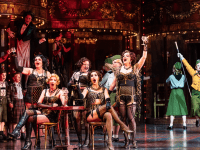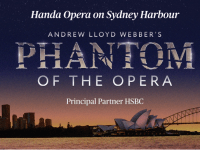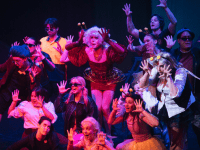 When you purchase tickets to a show you have a level of expectation for that show. When I purchased tickets to my first Chunky Move performance, Connected, as part of the 2011 Dance Massive program, the expectation was insurmountable. I was expecting excellence in performance, 21C uses of technology and thought provoking ideas portrayed through abstract movement. This is what I had come to know about Gideon Obarzanek’s work through friends and family and I was not disappointed. Housed at the Malthouse Theatre, an intimate space was orderly arranged with an intriguing set. A large wheel reminiscent of an 18th century spinning wheel was attached to numerous thread like metal ropes hanging in thin air. Dull lighting set the mood with a single spot of light projected onto the floor reminding me of a ball of wool being unravelled.
When you purchase tickets to a show you have a level of expectation for that show. When I purchased tickets to my first Chunky Move performance, Connected, as part of the 2011 Dance Massive program, the expectation was insurmountable. I was expecting excellence in performance, 21C uses of technology and thought provoking ideas portrayed through abstract movement. This is what I had come to know about Gideon Obarzanek’s work through friends and family and I was not disappointed. Housed at the Malthouse Theatre, an intimate space was orderly arranged with an intriguing set. A large wheel reminiscent of an 18th century spinning wheel was attached to numerous thread like metal ropes hanging in thin air. Dull lighting set the mood with a single spot of light projected onto the floor reminding me of a ball of wool being unravelled.
The dance was broken into 3 sections as Gideon described after the performance, “A, B and then A+B”. The dance began dramatically with almost unbearable ear piercing music. The vibrant movements had the dancers throwing themselves all over the floor, contorting, contracting and contrasting with each other. The costumes simple and effective, in a traditional modern contemporary black, with one female dancer in white looked visually interesting and made me wonder why she was singled out. As the dancers accumulate and disperse on one side of the stage it is interesting to note the other dancers putting together a puzzle on the opposite side of the stage. At times I was so engaged with the physical movements of the dance I hardly noticed the artwork being formed.
As the lighting changes to a hazing white I am reminded of an asylum and I am hypnotised, until there are long sections of string being removed from underneath the structure. What are they doing? What is that thing? At this stage I am so intrigued by the prop and have so many questions about its place in the piece that I don’t have a clue what the physical movements of the duo are. Soon the dancers are physically connected to the strings and as the sculpture begins to move it is beautiful and mystifying. As it moves gracefully through the air it is as though the sculpture has life and you now see how Obarzanek could be so inspired by Reuben Margolin’s work. The artist, who’s over sized mechanical wave installations are most usually seen in art galleries or other such public arenas, agreed to create the sculpture for the piece after Obarzanek explained his inspiration of dancer’s bodies manipulating the art work. The degeneration of technology and return to mechanical origins is an interesting twist for Obarzanek.
In more recent works such as Mortal Engine and Glow he has experimented with 21C technologies in body, sound and light. Connected, however, was a move back to a simpler idea of interactivity without the advanced special effects. The ability to transform the idea into reality however, was less than simple, working with Margolin long distance and trying to conceptualise the way in which the sculpture would physically work in connection with the dancers.
While Obarzanek was working on this concept he was simultaneously creating a documentary for a piece based on the work of security guards within art galleries as a side project. Something he had become increasingly interested in and eventually he decided to create that idea into a movement piece that would discover the flip side of the sculpture. Initially the piece takes us on a journey of the sculpture but then abruptly we are looking into a gallery and seeing it as a thing, no longer having life or breath but as an object on display, not to be interacted with or understood but to observe. In this section of the piece realism clashes with the abstract and is coupled by voice overs and dialogue from the dancers. The rhythm is created through the footwork and movement of the dancers and less from a soundtrack. The dancers use repetition, gestures and signals to give us an insight into the world of a security guard within an art gallery.
In a way this monotonous movement is clockwork and mechanical just like the sculpture itself. As the movements become more abstract and mirror those from the beginning it is evident of the union of the sculpture and the human element. The use of shape and percussive rhythmical isolations of the body is precise and technically succinct. Accepting the sculpture and connecting to it allows the dancers to be captured, succumbing to the physical connection between the dancers and the sculpture. Left breath taken and wanting more, I was excited by the harmony of art forms and interested to know, what is next for Gideon Obarzanek? Leaving chunky move does not mean leaving the dance world, Gideon explains, and once his commitments touring with his Chunky Move works is complete he will embark on new projects. Personally, I can not wait to see what he has in store for us next.









